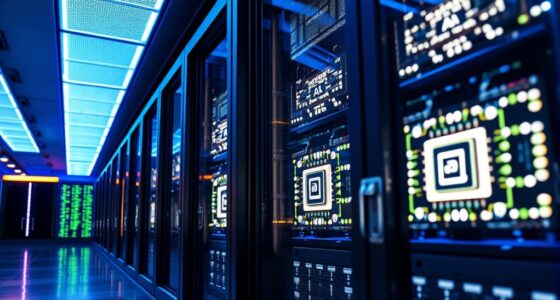Quantum Computing Initiative Takes Shape
During Microsoft’s fiscal‐year 2025 fourth‐quarter earnings call, CEO Satya Nadella signaled a strategic pivot from simply building AI capacity to pursuing error‑corrected quantum computing. He told analysts that quantum computing is “the next big accelerator in the cloud,” and that Microsoft’s road map spans “decade‑long arcs” even while delivering progress every quartermicrosoft.com. This comment marked the formal debut of Microsoft’s quantum era, underscoring the company’s confidence that quantum technology will eventually accelerate artificial intelligence workloads rather than merely complement them.
World’s first operational Level‑2 system
Microsoft’s pivot was backed by a concrete milestone: the first operational Level‑2 quantum system. In collaboration with Atom Computing, Microsoft developed a machine that uses error‑correcting codes to create logical qubits that maintain coherence over time. This Level‑2 designation means the system applies quantum error correction to stabilize computations; previous quantum devices (Level 1 or below) lacked such error tolerance. According to the earnings call, the system delivered 24 logical qubits, a record at the timereuters.com.
Neutral‑atom architecture and the Magne project
Unlike Google and IBM, which pursue superconducting qubits, Microsoft and Atom Computing are betting on neutral‑atom hardware. Neutral atoms are trapped in optical tweezers and manipulated with lasers, which scales more easily than superconducting circuits. Building on the Level‑2 prototype, Microsoft announced “Magne,” an ambitious quantum computer slated to start construction in autumn 2025. Magne will employ 50 logical qubits built from about 1,200 physical qubits—a scale that could offer quantum advantage and meaningful error tolerancecoincentral.comquantumcomputingreport.com. Microsoft aims to begin work on Magne in late 2025 and deliver early workloads by 2027, with the facility located in Copenhagen through the QuNorth initiativecoincentral.com. A Reuters report notes that Denmark’s Export and Investment Fund (EIFO) and the Novo Nordisk Foundation will invest €80 million ($93 million) in the project, and that construction will begin in the autumn of 2025 with the computer expected to be ready by the end of 2026reuters.com. Microsoft’s neutral‑atom approach thus positions the company to deliver one of the world’s first commercially available fault‑tolerant quantum computers.
Full‑stack integration and Denmark’s QuNorth program
Magne will be more than a collection of qubits: it’s planned as a full‑stack system integrating Atom Computing’s hardware, Microsoft’s Azure Quantum software, control electronics and error‑correction algorithms. The Danish‑backed QuNorth initiative aims to build and operate Magne as part of a wider European quantum ecosystem. Reuters notes that the computer will start with 50 logical qubits and will be delivered by Atom Computing while Microsoft provides softwarereuters.com. Denmark’s involvement reflects the growing geopolitical importance of quantum technology. According to IceNews, the investment is intended to make the Nordic region a leading hub for drug discovery, materials science and other applicationsicenews.is.
Strong Financial Performance Fuels Investment
Microsoft’s quantum ambitions rest on a solid financial foundation. The company’s fiscal‐year 2025 fourth quarter produced $76.4 billion in revenue, $34.3 billion in operating income and $3.65 diluted earnings per share (EPS)—all above Wall Street expectationsmicrosoft.com. Revenue grew 18 % year over year, while Azure and other cloud services revenue jumped 39 %microsoft.com. These results highlight the resilience of Microsoft’s cloud business, which remains the primary cash engine for funding new technology bets.
The earnings call revealed that AI workloads drove much of Azure’s growth, but Nadella emphasized that quantum computing will eventually become the next big acceleratormicrosoft.com. The financial strength allowed Microsoft to announce an approximately $30 billion capital‑expenditure plan for fiscal 2026, focused on adding data‑center capacitycoincentral.com. CFO Amy Hood said capex would increase from roughly $20 billion a year earlier to support surging AI and quantum demandinvestopedia.com. Azure now operates more than 400 data‑center sites across 70+ regions, and the company has committed to liquid‑cooling designs in all new facilitiesdatacenters.microsoft.com. According to Data Center Frontier, Microsoft’s next‑generation data centers use zero‑waste water‑cooling systems powered by 20‑foot fans, enabling energy‑efficient operation of AI and quantum workloadsdatacenterfrontier.com.
Financial snapshot
| Metric (Q4 FY2025) | Value | Sources |
|---|---|---|
| Revenue | $76.4 billion | Microsoft press releasemicrosoft.com |
| Operating income | $34.3 billion | Microsoft press releasemicrosoft.com |
| Diluted EPS | $3.65 | Microsoft press releasemicrosoft.com |
| Azure & other cloud services growth | 39 % year‑over‑year | Microsoft press releasemicrosoft.com |
| Planned FY2026 capex | ≈ $30 billion | Earnings call/Investopediacoincentral.cominvestopedia.com |
Microsoft’s ability to generate strong cash flows while increasing capex underscores why it can pursue long‑term quantum projects. The company also boasts a massive infrastructure footprint—over 400 data centers and more than 70 Azure regions—providing the physical backbone to host advanced quantum hardwaredatacenters.microsoft.com.
Industry Impact and Analyst Reception
The quantum announcement has reverberated across the technology landscape. During the earnings call, Nadella described a “decade‑long arc” for quantum developmentmicrosoft.com, yet analysts responded favorably, noting Microsoft’s track record of delivering on long‑term bets. CoinCentral reported that KeyBanc upgraded Microsoft’s stock to “Overweight” with a $630 price target, while Mizuho and Melius Research declared it a “must‑own” stock as the company approached a $4 trillion market capitalizationcoincentral.com. These endorsements reflect investor confidence in Microsoft’s ability to monetize AI and quantum innovations.
Microsoft’s quantum push also boosted the broader quantum computing sector. A Reuters report from February 2025 observed that quantum stocks rallied after Microsoft unveiled its Majorana 1 chip: IonQ’s stock rose about 2.1 %, Rigetti gained 6.9 %, and other firms like D‑Wave and Quantum Computing Inc. also advancedreuters.com. Such movements indicate that Microsoft’s innovations can provide a rising tide for other quantum players.
Why Level‑2 Matters and How Microsoft’s Approach Differs
Quantum computers process information using qubits that can exist in superpositions of 0 and 1. However, qubits are fragile—environmental noise quickly corrupts quantum states. Level‑2 machines incorporate quantum error correction to create logical qubits that maintain coherence much longer than individual physical qubits. Microsoft’s prototype generated 24 logical qubits using neutral atomsreuters.com, and aims for 50 logical qubits in Magnecoincentral.com. In contrast, Google’s latest devices rely on superconducting circuits, while IBM pursues both superconducting qubits and new error‑correction techniques. Microsoft’s neutral‑atom architecture may scale better because atoms are uniform and can be arranged in large arrays without complex wiring.
The company’s road map is thus designed for a long horizon. Jason Zander, Microsoft’s executive vice president, told Reuters that when the system reaches 50 logical qubits, it will hit true quantum advantage—problems that cannot be solved on classical computersreuters.com. At 100 logical qubits, the machine could tackle complex scientific calculations, and beyond 1,000 logical qubits, it could solve almost any computational problemreuters.com. Microsoft’s partnership with Atom Computing and Denmark’s QuNorth is therefore a stepping stone toward large‑scale, fault‑tolerant quantum computing.
Nadella’s Decade‑Long Vision
Nadella encapsulated Microsoft’s approach during the earnings call: “This is how we will continue to think and make investments, with decade‑long arcs, while making progress every quarter”microsoft.com. This philosophy, coupled with strong cash flows, allows Microsoft to pursue moonshot projects while still rewarding investors in the near term. By positioning quantum computing as the next accelerator for cloud and AI workloads, the company is not only diversifying beyond traditional software but also shaping the future of computing.
Conclusion
Microsoft’s announcement marks a turning point in the race for practical quantum computing. With the first operational Level‑2 system already achieved and the ambitious Magne project on the horizon, the company is staking its claim on a technology that could redefine computational limits. Strong financial performance and robust data‑center expansion provide the resources to pursue this vision, while neutral‑atom hardware and full‑stack integration set Microsoft apart from its competitors. As Nadella’s decade‑long arc unfolds, the fusion of quantum computing and artificial intelligence may usher in a new era where complex problems once deemed impossible become tractable. For investors and the broader tech industry, Microsoft’s quantum leap offers both promise and proof that the next computing revolution is already underway.









